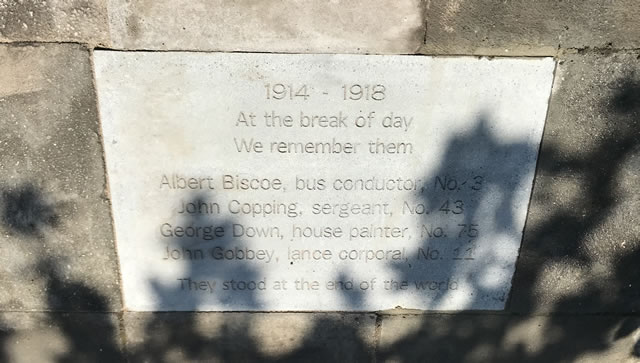Making history as the first London street to commemorate residents who fell in WW1
 Local councillor Mike Ryder will officially unveil the stone at the summer street party
Local councillor Mike Ryder will officially unveil the stone at the summer street party
|
Festing Road, the Putney Street has made history. This SW London street of 70 terrace houses has become the first street to commemorate its residents who fell in the 1914-18 war. Work by the Wandsworth Historical Society has identified details of the 343 Putney men who died in the Great War. Four came from Festing Road, famous for being the birthplace of Mr Benn the BBC cartoon character.
Street resident Hugh Thompson says: “Everyone has a grandfather or great grandfather who fought in that awful war, I had great uncles as well. Remembering with an engraved paving stone the Festing Four is our way of commemorating and honouring their sacrifice. This being one hundred years since the end of the war to end wars, its a good time. Local councillor Mike Ryder is officially unveiling the stone at our street party at the end of June. This is a street that does things together, this is the third stone we have put down and paid for, we plant our own bulbs, we have regular parties, named a pathway. Mr Benn would be proud of us.”
 Thamesfield councillor Mike Ryder said: “I am delighted to help Festing Road honour its heroes, because my own grandfather, who had the glorious name of Francis Noah Walden, was a sergeant major in the Royal Fusiliers throughout all the major battles of the First World War but was killed just 24 hours before it ended, on November 10, 1918. As I’ve said before, our past helps us shape our future, so I really admire Festing Road’s spirit of community feeling.”
Thamesfield councillor Mike Ryder said: “I am delighted to help Festing Road honour its heroes, because my own grandfather, who had the glorious name of Francis Noah Walden, was a sergeant major in the Royal Fusiliers throughout all the major battles of the First World War but was killed just 24 hours before it ended, on November 10, 1918. As I’ve said before, our past helps us shape our future, so I really admire Festing Road’s spirit of community feeling.”
The four being commemorated are Albert Biscoe a bus conductor; John Copping who died February 1919 a sergeant and is buried in the British cemetery, Pas de Calais; Arthur Down a house painter,died in action July 1917 also buried at the Pas de Calais and John Gobbey a lance corporal who died of wounds in 1915 and is buried in Hampshire.
Hugh Thompson says, ”We have chosen “They stood at the end of the world” as the inscription as its a combination of two lines from war poet Wilfred Owen’s “Spring Offensive” which sum up what they must have felt , such were the casualties that they knew very well that they may be going to their deaths, and yet their sense of duty made them go. We can only shake our heads and honour them. The line also says something about how we have changed.”
June 1, 2018